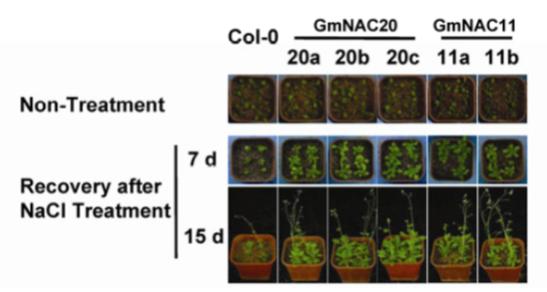NAC transcription factors play important roles in plant growth, development and stress response. Multiple NAC genes were identified in soybean by Drs. CHEN Shouyi and ZHANG Jinsong’s groups in the Institute of Genetics and Developmental Biology in the past few years. Recently the scientists of the two groups identified the roles of two genes, GmNAC11 and GmNAC20, in stress response and other processes.
They found that the two genes were differentially induced by multiple abiotic stresses and plant hormones, and their transcripts were abundant in roots and cotyledons. Both genes encoded proteins that localized to the nucleus and bound to the core DNA sequence CGT[G/A]. In the protoplast assay system, GmNAC11 acts as a transcriptional activator, whereas GmNAC20 functions as a mild repressor; however, the C-terminal end of GmANC20 has transcriptional activation activity. The overexpression of GmNAC20 enhances salt and freezing tolerances in transgenic Arabidopsis plants; however, GmNAC11 overexpression only improves salt tolerance. The overexpression of GmNAC20 also promotes lateral root formation. GmNAC20 may regulate stress tolerance through the activation of the DREB/CBF-COR pathway, and it may control lateral root development by altering auxin signaling-related genes. GmNAC11 likely regulates DREB1A and other stress-related genes. The roles of the two GmNAC genes in stress tolerance were further analyzed in soybean transgenic hairy roots. These results provide a basis for genetic manipulation to improve the agronomic traits of important crops.
This work has been online published on the Plant Journal (DOI:10.1111/j.1365-313X.2011.04687.x)on 24 JUN, 2011.
AUTHOR CONTACT:
ZHANG Jinsong, Ph.D.
Institute of Genetics and Developmetnal Biology, Chinese Academy of Sciences, Beijing, China.
E-mail: jszhang@genetics.ac.cn
Or
Prof. CHEN Shouyi.
Institute of Genetics and Developmetnal Biology, Chinese Academy of Sciences, Beijing, China.
E-mail: sychen@genetics.ac.cn

Figure 1. The seedlings were transferred to a medium with 150 mM NaCl and maintained for 10 d. After the treatment, all seedlings were transferred into pots with vermiculite soil for recovery. Under normal conditions, no obvious difference was observed between the control and transgenic plants (Figure 4a). After recovery for 7 d from the 150 mM NaCl treatment, the transgenic plants displayed better performance than Col-0 as judged from rosette size (Figure 4a). After a 15 d recovery, ~40% of wild-type plants survived, whereas more than 60% of the transgenic plants overexpressing GmNAC11 or GmNAC20 survived. For the GmNAC20 transgenic line 20c, the survival rate was over 80%. The rosette diameters of the transgenic plants were also significantly larger than those of wild-type plants. (Image by HAO Yujun etc.)



